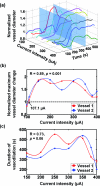Photoacoustic microscopy of microvascular responses to cortical electrical stimulation
- PMID: 21806263
- PMCID: PMC3144972
- DOI: 10.1117/1.3594785
Photoacoustic microscopy of microvascular responses to cortical electrical stimulation
Abstract
Advances in the functional imaging of cortical hemodynamics have greatly facilitated the understanding of neurovascular coupling. In this study, label-free optical-resolution photoacoustic microscopy (OR-PAM) was used to monitor microvascular responses to direct electrical stimulations of the mouse somatosensory cortex through a cranial opening. The responses appeared in two forms: vasoconstriction and vasodilatation. The transition between these two forms of response was observed in single vessels by varying the stimulation intensity. Marked correlation was found between the current-dependent responses of two daughter vessels bifurcating from the same parent vessel. Statistical analysis of twenty-seven vessels from three different animals further characterized the spatial-temporal features and the current dependence of the microvascular response. Our results demonstrate that OR-PAM is a valuable tool to study neurovascular coupling at the microscopic level.
Figures







Similar articles
-
In vivo dynamic process imaging using real-time optical-resolution photoacoustic microscopy.J Biomed Opt. 2013 Feb;18(2):26001. doi: 10.1117/1.JBO.18.2.026001. J Biomed Opt. 2013. PMID: 23377002
-
Quantitative estimates of stimulation-induced perfusion response using two-photon fluorescence microscopy of cortical microvascular networks.Neuroimage. 2012 Jul 2;61(3):517-24. doi: 10.1016/j.neuroimage.2012.04.009. Epub 2012 Apr 12. Neuroimage. 2012. PMID: 22521258
-
Cerebral microvascular network geometry changes in response to functional stimulation.Neuroimage. 2013 May 1;71:248-59. doi: 10.1016/j.neuroimage.2013.01.011. Epub 2013 Jan 25. Neuroimage. 2013. PMID: 23353600
-
Photoacoustic imaging and characterization of the microvasculature.J Biomed Opt. 2010 Jan-Feb;15(1):011101. doi: 10.1117/1.3281673. J Biomed Opt. 2010. PMID: 20210427 Free PMC article. Review.
-
Seeing Through the Surface: Non-invasive Characterization of Biomaterial-Tissue Interactions Using Photoacoustic Microscopy.Ann Biomed Eng. 2016 Mar;44(3):649-66. doi: 10.1007/s10439-015-1485-2. Epub 2015 Oct 15. Ann Biomed Eng. 2016. PMID: 26471785 Free PMC article. Review.
Cited by
-
Photoacoustic and optical coherence tomography of epilepsy with high temporal and spatial resolution and dual optical contrasts.J Neurosci Methods. 2013 Jun 15;216(2):142-5. doi: 10.1016/j.jneumeth.2013.04.001. Epub 2013 Apr 17. J Neurosci Methods. 2013. PMID: 23603664 Free PMC article.
-
Frontiers in optical imaging of cerebral blood flow and metabolism.J Cereb Blood Flow Metab. 2012 Jul;32(7):1259-76. doi: 10.1038/jcbfm.2011.195. Epub 2012 Jan 18. J Cereb Blood Flow Metab. 2012. PMID: 22252238 Free PMC article. Review.
-
Tutorial on photoacoustic tomography.J Biomed Opt. 2016 Jun;21(6):61007. doi: 10.1117/1.JBO.21.6.061007. J Biomed Opt. 2016. PMID: 27086868 Free PMC article. Review.
-
Photoacoustic tomography: principles and advances.Electromagn Waves (Camb). 2014;147:1-22. doi: 10.2528/pier14032303. Electromagn Waves (Camb). 2014. PMID: 25642127 Free PMC article.
-
Functional photoacoustic imaging: from nano- and micro- to macro-scale.Nano Converg. 2023 Jun 19;10(1):29. doi: 10.1186/s40580-023-00377-3. Nano Converg. 2023. PMID: 37335405 Free PMC article. Review.
References
-
- Frostig R. D., Lieke E. E., Ts'o D. Y., and Grinvald A., “Cortical functional architecture and local coupling between neuronal activity and the microcirculation revealed by in vivo high-resolution optical imaging of intrinsic signals,” Proc. Natl. Acad. Sci. U.S.A. 87(16), 6082–6086 (1990).10.1073/pnas.87.16.6082 - DOI - PMC - PubMed
-
- Culver J. P., Durduran T., Furuya D., Cheung C., Greenberg J. H., and Yodh A. G., “Diffuse optical tomography of cerebral blood flow, oxygenation, and metabolism in rat during focal ischemia,” J. Cereb. Blood Flow Metab. 23(8), 911–924 (2003).10.1097/01.WCB.0000076703.71231.BB - DOI - PubMed
Publication types
MeSH terms
Grants and funding
LinkOut - more resources
Full Text Sources
Other Literature Sources
Miscellaneous

